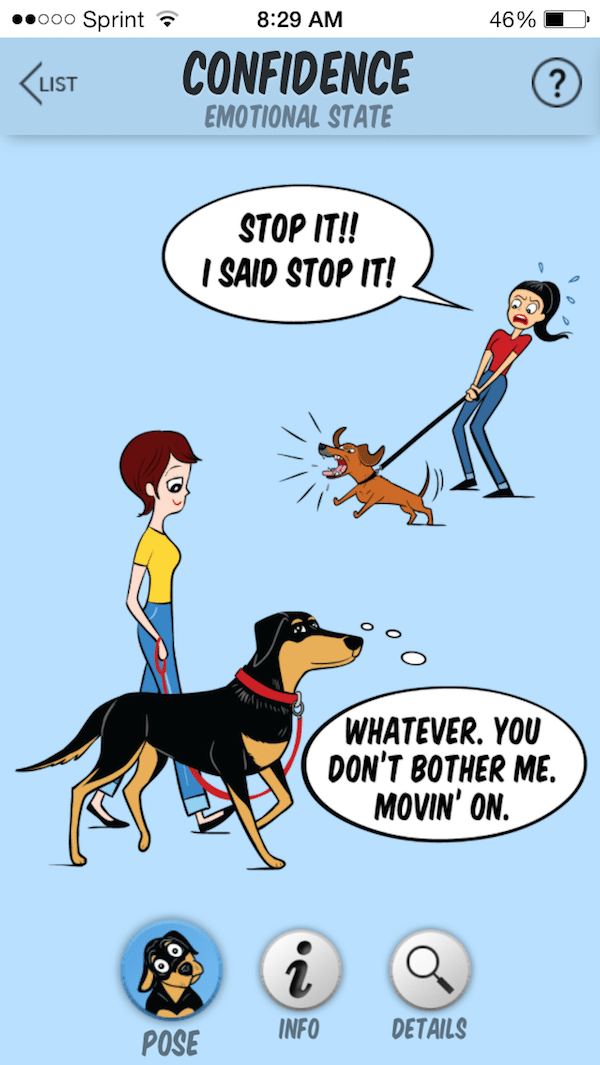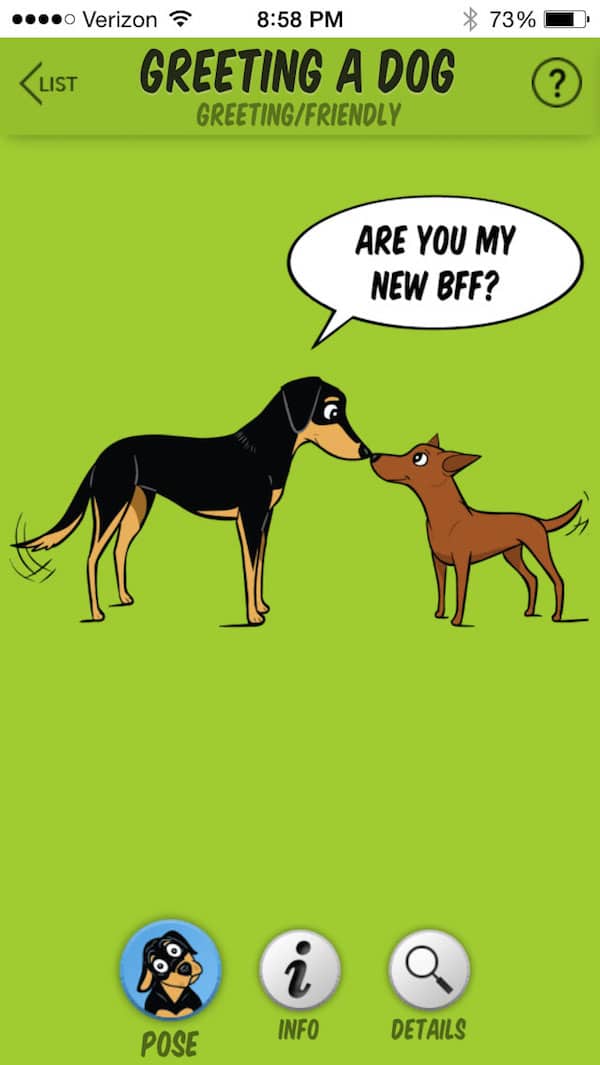A confident dog is sound in mind and only asserts himself if he is being physically threatened. Raising a puppy to be self-assured takes time, energy, and patience. Early socialization is your first step in building confidence. There is a proper way to do so, a path that will foster healthy relationships between your puppy and people, his environment, and other dogs and animals.

The top dog is not calm, but the bottom one is. (Image courtesy Dog Decoder smartphone app/illustration by Lili Chin of Doggie Drawings)
But first, let’s talk about the consequences of NOT taking this important step with your puppy.
The number one reason dogs are turned in to animal shelters is “bad behavior.” These undesirable actions stem from a lack of early training and socialization. Veterinarians now recommend that puppies start socializing at 8 weeks of age, instead of waiting until they have gotten all of their vaccines. In fact, the American Animal Hospital Association released clearly defined guidelines stating the importance of early socialization.
When a puppy hits adolescence without this support, he can become rowdy and out of control. Some owners will get fed up and give up on their dog. People forget that puppy behavior is normal — it’s not the dog’s fault! At blame is the pet parent’s lack of awareness and education in how to raise a dog so he can sail through puppyhood and adolescence to remain a best friend.
Just taking a puppy to class at 6 months of age doesn’t get the job done, though. Training consistently and patiently for his first two years is what allows a puppy to grow into a well-adjusted dog.
If you want a dog who can go anywhere and be with everyone, who likes all animals, and who behaves appropriately while you have dinner or guests over, you must put in the time and effort.

Two confident dogs meeting for the first time. (Image courtesy Dog Decoder smartphone app/illustration by Lili Chin of Doggie Drawings)
Tips for building your puppy’s confidence:
- Have play dates with fully vaccinated, confident dogs of all ages.
- Go for rides in the car often and to fun places, such as short trips to see playmates.
- Take trips to the vet’s office for fun visits, such as to get a treat, increasing the time spent there to meet staff, get weighed, and go into an exam room, all when you are NOT there for an appointment. This will decrease stress and anxiety during exams.
- Touch your puppy’s ears, feet, nails, and entire body regularly. This will prepare him for handling by veterinary staff and groomers.
- Learn how to read dog body language so you know when to intervene, do more training/exposure, or take a step back if your puppy is too cautious or overexcited. My Dog Decoder app can help.
- Encourage your puppy to explore different environments while you observe how he learns and moves in the world.
- Bring your puppy with you wherever you can and introduce her to 100 faces/places in 100 days, moving slowly and paying attention to his body language to know if he’s becoming stressed or is having fun.
- Go for hikes in safe places, letting him enjoy being a puppy. Do stay away from dog parks until all vaccinations are complete.
- Let your puppy sleep with you or at least, keep him in the same room as you in an exercise pen or crate.
- Create your own agility course in your own backyard or out in nature. See a downed tree or a small boulder? Say “Up” to your pup, and then lift him onto the tree, and when he feels steady on his feet, ask him to take a few steps. Repeat until he can jump up all by himself and walk along the trunk. New textures and surfaces help build confidence.
- Teach training cues at home first and then everywhere you can, while keeping it fun. Make sessions short and focused, with tons of playtime before and after, and tons of treats for encouragement. Teaching cues such as “Stay” is one of the best confidence builders. It teaches focus and patience.
- Teach games such as Fetch, Tug-o-War, and Hide and Seek, which allow you to teach the “Get It” “Drop It,” “Ready,” “Hold,” “Wait,” and “Find It” cues as well.
Do all of the above until your puppy hits his age of maturity, and you’ll have one of the happiest and most confident dogs you’ve ever enjoyed.
About the author: Jill Breitner is a professional dog trainer and dog body language expert. She a certified Fear Free Professional, has completed the Animal Behavior and Welfare course, and is the author of Dog Decoder, a smartphone app about dog body language. Join Jill on her Dog Decoder Facebook page.
The post How to Raise a Confident Puppy appeared first on Dogster.
No comments:
Post a Comment